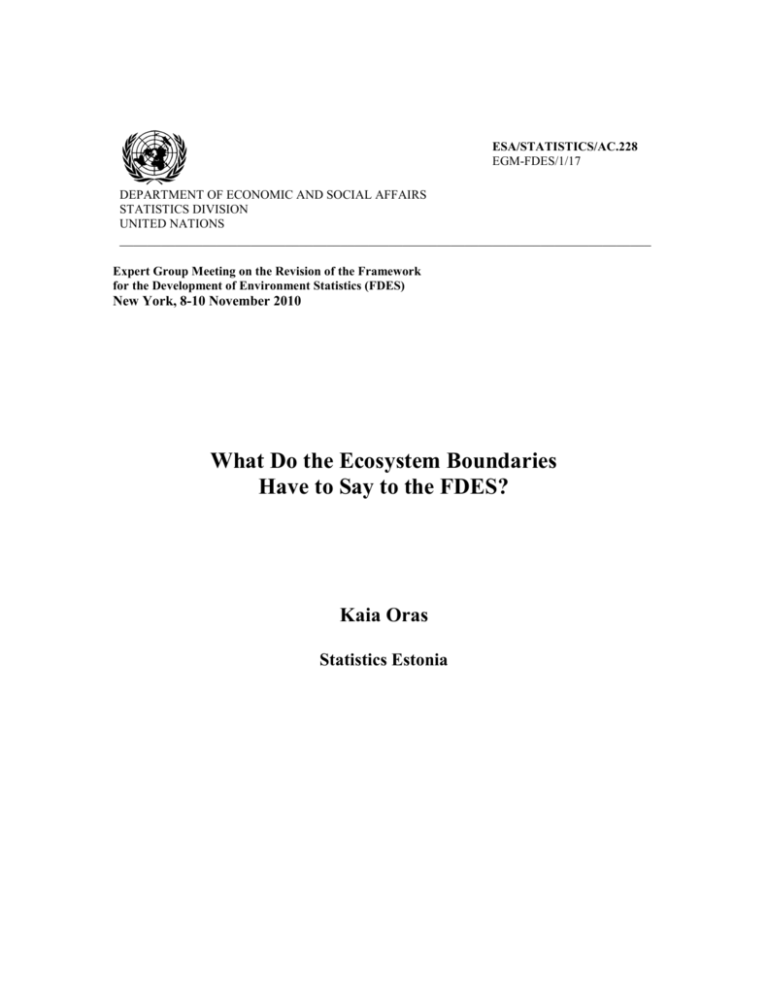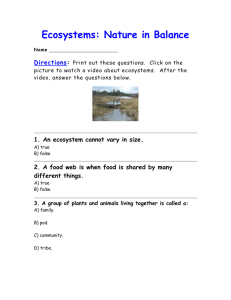What Do the Ecosystem Boundaries Have to Say to the FDES?
advertisement

ESA/STATISTICS/AC.228 EGM-FDES/1/17 DEPARTMENT OF ECONOMIC AND SOCIAL AFFAIRS STATISTICS DIVISION UNITED NATIONS _____________________________________________________________________________ Expert Group Meeting on the Revision of the Framework for the Development of Environment Statistics (FDES) New York, 8-10 November 2010 What Do the Ecosystem Boundaries Have to Say to the FDES? Kaia Oras Statistics Estonia How to operationalize the ecosystem approach? Take the ecosystem boundaries and limit factors under the scope and zoom down to everything that needs to be measured in order to keep the human society in the safe planetary ecosystem limits. The conclusions of the first Expert Group Meeting (EGM) for the Revision of the Framework for the Development of Environment Statistics (FDES) agreed that the ecosystem approach is a promising conceptual foundation for a future framework of environment statistics and it was considered to be the basis for the revision of the framework.1 The conclusions of the first EGM meeting also suggested that the revised framework (FDES) should be scientifically based and at the same time sufficiently responsive to emerging new scientific and political agendas.2 This paper discusses, first, how the planetary boundaries, FDES and “ecosystem approach” can be related. Then, it proposes that the recently described and quantified important limits in ecological cycles should be taken into consideration in order to tighten the scope of environment statistics. Secondly, it suggests that a circle of DPSIR indicators should be developed and implied for relevant anthropogenic pressures in order to create a feedback loop for the present and future policies. How can the Earth’s boundaries, FDES and “ecosystem approach” be related? Framework for the development of Environment Statistics (1984) states that there is no generally accepted model or classification on environment and no attempt has been made to establish an a priori definition that goes beyond the broad concept of statistics related to the environment. Only the scope of such statistics, as perceived by major users and producers of environmental data, is examined (chapter I, A, paragraph 11). From the environment statistics perspective, also the “ecosystem approach” is not easy to understand and apply directly. Intuitively, the “ecosystem approach” can however be well understood. The definition of the “ecosystem approach” can be found in the Convention on Biological Diversity which defines it as follows: ”The ecosystem approach is a strategy for the integrated management of land, water and living resources that promotes conservation and sustainable use in an equitable way. It is based on the application of appropriate scientific methodologies focused on the levels of biological organisation which encompass the essential processes, functions and interactions among organisms and their environment. It recognises that humans, with their cultural diversity, are an integral component of ecosystems.“3 An ecosystem approach is both a framework for planning and management decisions and a process by which decisions are made 4. 1 (E/CN.3/2010/9, § 21). (E/CN.3/2010/9, § 23) 3 http://www.cbd.int/ecosystem/ 4 Adopting an ecosystem approach: Local variability in... By: Kellogg, Wendy A., Society & Natural Resources, 08941920, Jul/Aug98, Vol. 11, Issue 5 2 2 So, the ecosystem is a very complex entity with many components which are in interaction with each other. Eugene Pleasants Odum known for his pioneering work on ecosystem ecology has defined ecosystems as "a system of complex interactions of populations between themselves and with their environment".5 However, from the viewpoint of maintaining the human and ecosystem balance (long-term goal of sustainable development) not the whole variety of interactions is relevant. As humans we are part of a vast variety of biogeochemical cycles. We know some of them well enough. The nitrogen cycle can serve as an example. Nitrates are applied as fertilisers on farmland. It can happen that plants do not absorb all of it. These nitrates then end up in water, where they can eventually cause eutrophication, the extensive growth of green algae, which can result in oxygen supply depletion, which in turn causes the death of fish and other oxygen-dependent organisms and the taking over of anaerobic bacteria. The phosphorus, nitrogen, carbon and water cycles are the most important cycles for us. Biogeochemical cycles which are not as relevant, are also less known. In addition, there are relatively unknown cycles, the speed, intensity, and balance of which have been affected by human impacts and the importance of which is hence growing. From the “ecosystem perspective” we can define human environment as humanities ecological niche. G.E. Hutchinson has modelled a “niche” as an imaginary space with many dimensions, in which each dimension or axis represents the range of some environmental condition or resource that is required by the species.6 The niche could be characterised by a range of environmental conditions which are defined and related to the most important cycles that we are part of. So the Earth’s boundaries, FDES and “ecosystem approach” could be related via the concept of humanities ecological niche. The relevant parameters of the humanities environmental “dimensions” of the ecological niche have to be considered in order to define the components of the environmental framework. The FDES document (1984) stipulates that refinement and adaptation of the framework are necessary as well as the continuous critical review of the purposes of the framework.7 As the knowledge of environmental problems has grown and the thresholds of the Earth ecosystems’ global cycles have become obvious and partially measureable, one of the improvements could be the widening of FDES “components of the environment” with the dimension of specific environmental limit factors. But how to do it? 5 Odum, 1975; Odum, E.P. 1975. Ecology. New York. Rinehardt and Wilson Pidwirny, M. (2006). "Concept of Ecological Niche".Fundamentals of Physical Geography, 2nd Edition.. http://www.physicalgeography.net/fundamentals/9g.html 7 ST/ESA/STAT/SER.M/78, A Framework for the development of environment statistics, New York 1984 6 3 Do the ecosystem limit factors in the Earth’s environment and the need to respect them define also the way forward for global environment statistics? Thresholds in the Earth’s environment and the need to respect them will probably define the way forward for global environment statistics in the future. However, the thresholds of the Earth ecosystems are difficult for the statistical community to deal with due to their scientific nature. The “Limits to Growth”8 by Donella Meadows and Club of Rome was the first wider known attempt of modelling the Earth's and human systems which brought the whole topic on the international arena. World population, industrialization, pollution, food production and resource depletion were the five modelled parameters regarding thresholds. Later studies have followed and refer, among other things, to concepts like safe minimum standards (suggesting decision rules to avoid environmental degradation beyond certain threshold levels), precautionary principle (“better safe than sorry“), tolerable window, etc. If we assume that maintaining of the ecologically safe space (niche) for the mankind is an important goal for the scientific and political agenda regarding global environment, then the framework for environment statistics should be a part of the information system which will operate as a policy feedback loop for implementing policies to reach this goal. Statistics on environmental processes (climate change, ozone layer depletion, etc.) and the respective cycles which are most important for us (carbon, phosphorus, nitrogen and water) are needed in order to evaluate the effectiveness of the measures taken for balancing thuman and ecosystem’s interactions. Scientific knowledge about the limits of ecosystems and the risks, that exceeding of these limits will bring about, have to be considered when drawing the environment statistics framework. Building of scientific knowledge into the global system of environment statistics will certainly pay back in the future. Planetary ecosystem’s boundaries/limits can be taken on board either while designing the framework or later when compiling the core set of statistics and indicators. If they were just numerical … Thresholds of planetary boundaries in the Earth’s environment Resilience Alliance (a group of 28 internationally renowned scientists) proposed an approach to global sustainability in which they define planetary boundaries9 within which they expect that humanity can operate safely. Resilience Alliance believes that this approach can show how the scientific understanding of Earth’s System can potentially be used for societal decision-making process. Planetary boundaries define the boundaries of the “planetary playing field” for the humanity if we want to be sure that we can avoid major human-induced environmental 8 Donella Meadows ; Limits to growth“, ISBN 0-87663-165-0 , 1972 (Johan Rockström et al: “Planetary Boundaries: Exploring the Safe Operating Space for Humanity”, Ecology and Society 14(2): 32, http://www.ecologyandsociety.org/vol14/iss2/art32/ ). 9 4 change on a global scale. Annex 1 presents the nine planetary boundaries in a graphical format. The inner green shading represents the proposed safe operating space for nine planetary systems. The red wedges represent an estimate of the current position for each variable. The boundaries in three systems (rate of biodiversity loss, climate change and human interference with the nitrogen cycle) have already been exceeded. Annex 2 outlines the same parameters accompanied by the thresholds, current and prehistorical values. Planetary boundaries cover the major global biogeochemical cycles of N, P, C and water, the physical circulation systems of the planet and biophysical features of the Earth which contribute to the underlying resilience of its self-regulative capacity. In addition, they cover two additional features associated with anthropogenic load (chemical pollution and aerosol loading). On the level of current scientific knowledge, quantifications are proposed for seven out of the nine planetary boundaries. Can the planetary boundaries be used for framing statistical issues in FDES and relevant information systems for both global and local issues? Can the identified (described) thresholds in the Earth’s environment and the need to respect the planet's climatic, geophysical, atmospheric and ecological processes help to define the bases for the priority framework also for global environment statistics? Is it needed? The planetary boundaries model makes a distinction between systematic processes on planetary level and aggregated processes on the local scale. A need for harmonised statistics is obvious for systematic processes on planetary level like climate change and ozone layer depletion. The main components of these anthropogenic pressures are well dealt with already by international organisations guiding the policies worldwide. In order to support the policies aimed at redirecting the development on sustainable pathways, statistical systems can contribute by developing information systems and estimation methods for driving forces and measures. Aggregated processes on local regional levels (which contribute to the global-scale problems) refer to the processes like the transfer of nitrogen and phosphorus into biologically available forms, land use change, fresh water use. For these global-level processes originating from local scales, the scope of environment statistics is quite variegated yet depending on the ecosystem type and the nature of environmental problems. For example, as statistical systems are not yet on the level of calculating nitrogen balances, the processes causing excess nitrogen are not well enough dealt with and monitored. 5 The local-scale environmental issues, however, due to their specific nature may remain “a la carte” in a framework, as they have been up to present. However, the comparability should be desired in definitions and methodologies. How to increase the relevance of environment statistics? In the same way as we expect the doctor to diagnose and treat the illness and not to take random tests, we as the architects of statistical system should focus our efforts on the areas and instruments that help to maintain or achieve ecological balance. Due to the lack of necessary rooting in the knowledge about global models, statisticians between themselves cannot build an effective global monitoring system for environment statistics. Statistical concepts are quite often built as a response to policy demand and, hence, the frameworks tend to be practical and political, not that much scientifically solid (if we could define it!). Eurostat has been talking quite a lot during the last years of the “quality triangle” for development indicators: the indicator system could be located in any of the corners of the triangle: either politically relevant (Europe 2020), consistent with theory (Stiglitz report) or well measurable (environmental accounts). To obtain a good quality simultaneously in all aspects is considered to be not easily feasible.10 Framework for the development of environment statistics could in an ideal world combine all three: scientific and political frameworks and a link to measurement frameworks (accounts). FDES should centrally have environmental pressures (respective to the limits) and linkages to accounting systems (regarding the human activities causing the pressures) and also components for monitoring the measures which again should be linked to the accounts. How to deal with the measures taken (response indicators)? Monitoring of the measures is important for creating an effective shift in the desired direction. Donella Meadows, a scientist and system analyst who focused on environmental limits has proposed 9 leverage points to intervene in a system (e.g. a corporation, an economy, an ecosystem)11. She describes a system as being in a certain state, and containing a stock, with inflows (amounts coming into the system) and outflows (amounts going out of the system). And if there is a goal for the system to be in a certain state, then both measures and the feedback loop are necessary in order to overcome the discrepancy. If we talk about the ecosystems as a system and us trying to reduce certain flows, interventions can happen on different levels of the system depending on the nature and scale of phenomena. Thus, a vast variety of aspects should also be analysed in order to come up with relevant information for the feedback loop. Statisticians could be seen as architects and the builders of the system. Several building blocks: the indicators and linkages which could provide the loop with the politics are still missing. 10 11 http://www.aicesis.org/IMG/pdf/100721_Radermacher_en.pdf Donella Meadows, Leverage points, Places to Intervene in a Sysem, Sustainabiliy Institute 1999 6 But still, why to relate the feedback loop to the statistical system? The aim of measuring environmental parameters and the impacts of relevant human activities have been and will be the short- and long-term sustainability and hence the need for the integration of key issues with other statistical accounts in the long run. is obvious. In addition to ecological limits and boundaries, the boundaries are also in the socio-economical sphere. Governments need answers to the following questions: what does it cost to shift away from the resource consuming and polluting patterns? What will happen if no action is taken? How to plan a long-term structural change to renewables? It is important to identify and keep an eye on the system limit factors in order to maintain a balance in development when finding solutions in the probably constricting economies. Moreover, the members of EGM note that “interactions (impacts and feedback) between the socio-economic system and the ecosystem should be at the core of such integration.12 If to create a framework which would work for the countries with advanced level statistical systems and the beginners or for those who might reside in completely different ecosystems with a different kind and level of economic development, the system could turn out very complicated. Regarding important aspects, the framework should be simple enough. Those who are taking their first steps in the development of environment statistics should find guidance regarding the main pressures and should be able to produce statistics on these main pressures important for directing environment policy in the countries concerned and globally as well. For others, who are already more advanced, the model should guide both the identification of other important aspects and the application of the methods of accounting in order to link economic activities to environmental pressures in a scientifically sound manner. Introduction of the ecosystems’ boundaries will also provide better bases for the communication of environment statistics. Quite often the users of statistics remain uncertain regarding the importance of figures and how to explain them (how to set them in a context). For two decades now, environment statisticians have faced an unanswered question: how to build a comprehensive environmental index. The application of the planetary boundaries concept can provide weights for the environmental index. If to build a comprehensive environmental index, than the indicators which values are closer to the threshold values should respectively get a higher weight in the index. 12 Environmental statistics, monitoring and assessment; Reflections by the European Environment Agency on the FDES Role and Revision, Jean-Louis Weber, UN Statistics Division in collaboration with Statistics Canada; Expert Group Meeting on the Framework for the Development of Environment Statistics; New York, 10-12 November 2009 7 Conclusions and next steps • Ecosystem boundaries and limit factors provide a possible key for operationalizing the ecosystem approach and tightening the scope of environment statistics. • The Earth’s boundaries, FDES and “ecosystem approach” can be related via the concept of humanities ecological niche. • The relevant parameters of ecological niche (limits, thresholds) can form a core part of the framework. • The 9 planetary boundaries (climate change, ocean acidification, stratospheric ozone depletion, biogeochemical nitrogen and phosphorus cycle, global fresh water use, land use change, loss of biological diversity, chemical pollution, atmospheric aerosol loading) proposed by the Resilience Alliance, should be analysed further and investigated from the environment statistics perspective. • A wider conceptual framework is the framework of sustainable development. Integration with the socio-economic sphere could be achieved via environmental accounts. But, in order to build an intelligent system, a solid scientific contribution to the development of FDES is needed. • The global level importance of environment issues calls for the development of harmonised statistics. Overview of the developments in the scientific research on global environment e.g. “big picture” should be at least on the central or leadership level of the statistical system. • In order to support the policies aimed at redirecting the development on sustainable pathways, statistical systems can contribute by developing information systems and estimation methods for driving forces and measures. Probably the whole complex of matrices could take the shape of a decision tree depending on a user point of interest or availability of the resources to produce statistics. But in order to build an intelligent system, a solid scientific contribution to the development of FDES is needed. Statisticians between themselves cannot build a global monitoring system of environment statistics because of the lack of necessary knowledge about global models. What can be the steps and tasks of the EGM? 1. First we have to consult relevant research institutes (for the Ecosystem Boundaries approach the Resilience Alliance, World Resource Institute and others) and ask for their suggestions on the best structure of the global environment statistics framework and its future development pathways. (Reason: scientific knowledge about the limits of ecosystems and the risks, that the 8 exceeding of these limits will bring about, have to be considered when drawing the environment statistics framework). 2. Besides that, it is also important to identify a relevant DPSIR -s for each environmental pressure/driver which leads to the planetary thresholds being exceeded, and bridges (links) to economic and social statistics via environmental accounts. 3. To build the system module by module, climate change could be the first topic and the materials prepared for Oslo conference on Climate Change and Official Statistics 13 could be used firsthand. 13 http://unstats.un.org/unsd/climate_change/docs/CC Climate_Change_Conference.handout_final.pdf 9 Annex 1. Beyond the boundaries. The inner green shading represents the proposed safe operating space for nine planetary systems. The red wedges represent an estimate of the current position for each variable. The boundaries in three systems (rate of biodiversity loss, climate change and human interference with the nitrogen cycle), have already been exceeded. Johan Rockström, Will Steffen, Kevin Noone, Åsa Persson, F. Stuart Chapin, III, Eric F. Lambin, Timothy M. Lenton, Marten Scheffer, Carl Folke, Hans Joachim Schellnhuber, Björn Nykvist, Cynthia A. de Wit, Terry Hughes, Sander van der Leeuw, Henning Rodhe, Sverker Sörlin, Peter K. Snyder, Robert Costanza, Uno Svedin, Malin Falkenmark, Louise Karlberg, Robert W. Corell, Victoria J. Fabry, James Hansen, Brian Walker, Diana Liverman, Katherine Richardson, Paul Crutzen & Jonathan A. Foley Nature 461, 472-475(24 September 2009), doi:10.1038/461472a 10 Annex 2. Planetary boundaries Johan Rockström, Will Steffen, Kevin Noone, Åsa Persson, F. Stuart Chapin, III, Eric F. Lambin, Timothy M. Lenton, Marten Scheffer, Carl Folke, Hans Joachim Schellnhuber, Björn Nykvist, Cynthia A. de Wit, Terry Hughes, Sander van der Leeuw, Henning Rodhe, Sverker Sörlin, Peter K. Snyder, Robert Costanza, Uno Svedin, Malin Falkenmark, Louise Karlberg, Robert W. Corell, Victoria J. Fabry, James Hansen, Brian Walker, Diana Liverman, Katherine Richardson, Paul Crutzen & Jonathan A. Foley Nature 461, 472-475(24 September 2009) doi:10.1038/461472a 11








